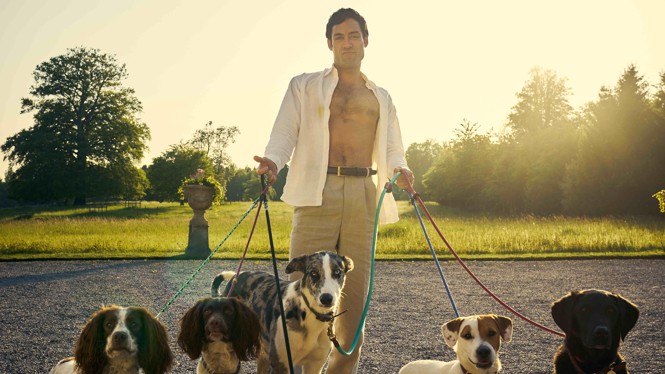What Trump Sees Coming
At one of his final dystopian rodeos, the former president hinted at 2025 and beyond.

This is an edition of The Atlantic Daily, a newsletter that guides you through the biggest stories of the day, helps you discover new ideas, and recommends the best in culture. Sign up for it here.
Maybe it was always building to this: thousands of people singing and dancing to “Macho Man,” some sporting neon safety vests, others in actual trash bags, a symbolic expression of solidarity with their authoritarian hero whose final week on the campaign trail has revolved around the word garbage.
Where will the MAGA movement go from here? Trump had an answer last night, at least for the short term. He wasn’t telegraphing an Election Day victory—he was preparing, once again, to label his opponents “cheaters” and to challenge a potential defeat.
The evening’s host, Tucker Carlson, said that for most of his life as a journalist, he’d imagined that one would have to be “bereft of a soul” to stand onstage and support a politician. “And here I am with a full-throated, utterly sincere endorsement of Donald Trump.”
On with the show.
As I wandered around Desert Diamond Arena, in Glendale, Arizona, last night, this iteration of Trumpism felt slightly different, if not wholly novel. Nine years ago, Trump held one of his first MAGA rallies not far from this venue. “Donald Trump Defiantly Rallies a New ‘Silent Majority’ in a Visit to Arizona” read a New York Times headline from July 11, 2015. Charlie Kirk, one of last night’s warm-up speakers, put it thusly: “This state helped launch the movement that has swept the globe.” All of the elements Trump needed to stoke the fire back then were still here last night: the Mexican border debate, inflamed racial tensions, metastasizing political extremism. Trump’s movement has grown, and his red MAGA hat has become a cultural touchstone. As the Arizona sun set, though, his nearly decade-long campaign of fear and despotism also had a surprising air of denouement.
Trump told Carlson he doesn’t like to look back. But last night, as he rambled (and rambled), he was sporadically reflective about all that had led to this point in his life. Trump sat in a leather chair with just a handheld mic—no teleprompter, no notes. He mostly ignored Carlson’s questions and instead tossed out ideas at random—what he calls “the weave.” In reality, it’s less lucid than he believes; more of a zigzag across years of personal triumphs and troubles. Remember “Russia, Russia, Russia”? Remember the “China virus”? Remember the time he courageously pardoned Scooter Libby? Remember how good he used to be at firing people on The Apprentice? Remember the crowd at that one Alabama rally? All of this, in his mind, amounted to something akin to a closing argument.
The event was a hurricane-relief benefit billed as Tucker Carlson Live With Special Guest Donald J. Trump. But Carlson barely spoke. Instead, he sat back in his own chair, occasionally picking at his fingers, looking somewhat mystified that this was where he’d ended up in his career, hosting Inside the Authoritarian’s Studio. He had taken the stage to the sounds of Kid Rock, but he looked as preppy as ever in a navy blazer, a gingham shirt, a striped tie, and khakis. He insisted, twice, that he had bent the knee to Donald Trump without shame. Trump, he marveled, had shown him what a sham D.C. was. He lamented how those inside the Beltway treated Trump “like he was a dangerous freak, like he’d just escaped from the state mental institution.”
Carlson has grown more radical since Fox News fired him. Last night, he claimed, for instance, that the CIA and the FBI have been working with the Democratic Party to take Trump down. He implied that funding for Ukraine isn’t going to the military but is instead lining the pockets of the Washington elite: “Have you been to McLean recently?”
The man he unabashedly endorsed, meanwhile, again spoke of “the enemy within,” and attacked the enemy of the people (the media). Trump once again demeaned his opponent, Vice President Kamala Harris, as a “low-IQ individual” and “dumb as a rock.” He claimed that members of the January 6 “unselect committee” had burned, destroyed, and deleted all the evidence it had collected because, in the end, they found out that Nancy Pelosi was at fault (this bit was especially hard to follow). He called for enlisting the “radical war hawk” Liz Cheney into combat: “Let’s put her with a rifle standing there with nine barrels shooting at her, okay? Let’s see how she feels about it, you know, when the guns are trained on her face.”
Trump blew some of his usual autocratic dog whistles, saying, for instance, that anyone who burns an American flag should be sentenced to a year in prison. He suggested that loyalists and extremists will fill his next administration, should it exist. He implied that he’d bring in Elon Musk to find ways to slash the federal budget, and let Robert F. Kennedy Jr., a vaccine skeptic and a conspiracy theorist, examine public-health matters. “He can do anything he wants,” Trump said of Kennedy.
But perhaps the most meaningful moment of the night was when Trump said matter-of-factly that he won’t run for president again. He instead hinted that his vice-presidential nominee, J. D. Vance, will be a top 2028 contender. Win or lose, this was it, his last dystopian rodeo. Trump spoke almost wistfully about suddenly approaching the end of his never-ending rally tour. He sounded like a kid moving to a new neighborhood and a new middle school. He told his friends he’d miss them. “We’ll meet, but it’ll be different,” he said. He was in no rush to leave the stage.
The big question going into Tuesday’s election is whether the MAGA movement will fizzle out should Trump lose. Although Trump himself seems more exhausted than usual these days, his supporters are as fired up as ever. “Fight! Fight! Fight!” chants— a reference to Trump’s now-infamous response to the July attempt on his life—broke out among the crowd as people waited to pass through Secret Service checkpoints. I passed a man in a brown wig, a pink blazer, and a green top that read Kamala Toe, the words gesturing toward his crotch. I saw a woman wearing gold Trump-branded sneakers, and many people with Musk’s Dark MAGA hat. The latter seemed particularly notable: In addition to getting behind Vance, Trump might be inclined to pass the torch to another nonpolitician—namely, someone like Musk.
For now, though, Trump is returning to his conspiratorial election denialism. Four years ago, he tried to undermine the results in Arizona, Georgia, and other states. Last night, he singled out Pennsylvania. (A day earlier, his campaign had filed a lawsuit in the state, alleging voter suppression.) “It’s hard to believe I’m winning, it seems by a lot, if they don’t cheat too much,” he said, alleging malfeasance in York and Lancaster counties. Whether he succeeds or fails, the detritus that Trump has left behind will likely linger. “Look around, Mr. President, because there’s a lot of garbage here!” Charlie Kirk said earlier in the night. “Go to the polls on Tuesday and make sure that we all ride that big garbage truck to Washington, D.C.,” Kennedy, who was one of the warm-up speakers, implored.
Trump, though, opined with uncharacteristic nostalgia: “When I was a young guy, I loved—I always loved the whole thing, the concept of the history and all of the things that can happen.” He sounded fleetingly earnest. He has undoubtedly cemented his place in history. Or, as Carlson put it earlier in the night: “Almost 10 years later, he has completely transformed the country and the world.”
Related:
Today’s News
- The White House altered its transcript of President Joe Biden’s call with Latino activists, during which official stenographers recorded that Biden called Trump supporters “garbage,” according to the Associated Press. The White House denied that Biden had been referring to Trump voters.
- During a meeting in Moscow, North Korea’s foreign minister pledged to support Russia until it wins the war against Ukraine.
- The price of Donald Trump’s social-media stock fell another 14 percent today, amounting to a loss of more than 40 percent over three days.
Dispatches
- Atlantic Intelligence: Although AI regulation is the rare issue that Trump and Harris actually agree on, partisanship threatens to halt years of bipartisan momentum, Damon Beres writes.
- The Books Briefing: These books are must-reads for Americans before Election Day, Boris Kachka writes.
Explore all of our newsletters here.
More From The Atlantic
- MAGA is tripping.
- Five of the election’s biggest unanswered questions
- The Georgia chemical disaster is a warning.
- The five best books to read before an election
Evening Read
This Might Be a Turning Point for Child-Free Voters
By Faith Hill
When Shannon Coulter first started listening to Kentucky Governor Andy Beshear’s speech at the Democratic National Convention in August, she thought it seemed fairly standard. “All women,” he said, “should have the freedom to make their own decisions, freedom over their own bodies, freedom about whether to pursue IVF.” But then he said something that she rarely hears from political leaders: Women should also have “freedom about whether to have children at all.” Beshear was recognizing that some Americans simply don’t want to be parents, Coulter, the president of the political-advocacy nonprofit Grab Your Wallet, told me. And that handful of words meant a great deal to her as a child-free person, someone who’s chosen not to have kids. “People are just looking,” she said, “for even the thinnest scraps of acknowledgment.”
Culture Break
Watch. Rivals (streaming on Hulu) is the silliest, sexiest show of the year, Sophie Gilbert writes.
Listen. We Live Here Now, a podcast by Lauren Ober and Hanna Rosin, who found out that their new neighbors were supporting January 6 insurrectionists.
Stephanie Bai contributed to this newsletter.
When you buy a book using a link in this newsletter, we receive a commission. Thank you for supporting The Atlantic.










